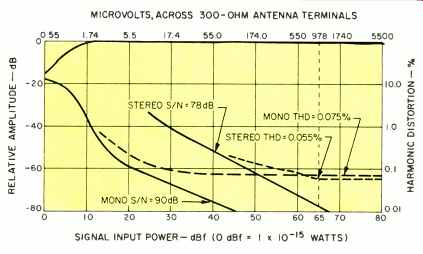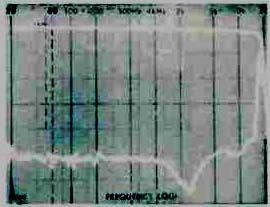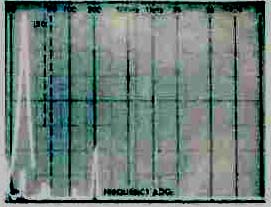
Manufacturer's Specifications
Mono Usable Sensitivity: 10.8 dBf (1 .9 µV).
50-dB Quieting Sensitivity: Mono, 16.8 dBf (3.8 µV); stereo, 37.3 dBf (40µV).
Signal-to-Noise Ratio: Mono, 92 dB; stereo, 87 dB.
THD: Mono, 0.05 percent at 100 Hz, 1 kHz and 10 kHz; stereo, 0.07 percent at 1 kHz, 0.08 percent at 100 Hz, and 0.20 percent at 10 kHz.
IM Distortion: Mono, 0.05 percent; stereo, 0.07 percent.
Selectivity: 90 dB.
Capture Ratio: 1.5 dB.
Frequency Response: 30 Hz to 15 kHz,. +0.2, -0.5 dB.
AM Suppression: 65 dB.
Image Rejection: 95 dB.
I.f. Rejection: 1 00 dB.
Spurious Rejection: 100 dB.
Sub-Carrier Rejection: 75 dB.
Muting and Tuning Threshold: Low, 25 dBf; high, 45 dBf.
Output Level: 750 mV.
Power Requirements: 120 V, 60 Hz, 20 W max.
Dimensions: 17 in. (43.18 cm) W x 3 1/4 in. (8.25 cm) H x 12 1/2 in. (31.75 cm) D.
Net Weight: 10 lbs., 10 oz. (4.78 kg).
Price: $450.00.
Until now, it has been commonly accepted that frequency synthesizing tuners offer more precise tuning than is possible with conventional mechanically tuned systems, but that they are inferior to the best of the variable-capacitor-tuned units insofar as signal-to-noise ratios and distortion figures are concerned. All of that will change now that Sony has introduced their new digital synthesized tuner, Model ST-J75. Its signal-to-noise ratio exceeds that of any tuner we have ever measured and is, in fact, unmeasurable on our presently available test equipment. Just how Sony managed to accomplish this feat will be explained presently, but for the moment let's examine the layout of this new product.
Near the center of the slim front panel is an alpha-numeric display area which shows tuned-to frequency, programmed station numbers (up to eight separate frequencies can be memorized and recalled at will), and the words "memory" and "set" which indicate readiness to program the tuner and to have it memorize station frequencies, when appropriate. Frequency display utilizes up to five digits so that incremental tuning may be accomplished in 50-kHz steps (e.g. 104.35).
To the left of the display area is a signal-strength indicating system consisting of five LEDs and several status words which become illuminated to indicate such things as method of tuning in use (manual or auto), status of muting (off, low level or high level), and mode (auto FM/FM stereo or stereo-only). The words "cal tone" below the signal-strength LEDs light up when the built-in 400-Hz calibration tone is activated.
A power switch is located at the extreme left of the panel. Below the display area and word indicator areas are a program on-off switch (used in conjunction with a separate, optional PT-77 timer for unattended recording), a button labeled "next call" used to set next programmed station, a memory-set/program set button, a memory scan button, the aforementioned 400-Hz calibration tone button, a mono/stereo mode switch, and a muting switch. The first touch of the muting switch turns off the muting and activates manual tuning. Successive touches of this switch introduce low-level or high-level muting in the auto-tuning mode. Just below the frequency display are a pair of tuning buttons which cause tuned-to frequencies to change in an up ward or downward direction, automatically or manually, depending upon the setting of the muting switch. The right section of the panel has eight push buttons, each of which can be set to recall a favorite station frequency. Tiny windows above each button can be "loaded" by the user with frequency numerals corresponding to the memorized station frequencies of each of the eight buttons. Sony calls them "multi-process" memories since they can go from any station to any station, randomly, in either mono or stereo mode, and will call up each station at the muting level required for each station. These station memories nonvolatile retained for as 10 with the power cord disconnected! When the "scan" button is pressed, the tuner tunes to each of the eight memorized frequencies in sequence, remaining at each frequency for about 3.5 seconds. If the listener likes what he or she hears at any of the settings, the "set" button is pressed to lock the program in, If the tuner is used with an external timer, such as Sony's seven-day programmable timer, the PT-77, it is possible to program for unattended recording and playing of up to eight preset stations in any sequence de sired.
The rear panel of the ST-J75 is equipped with the usual 300-ohm and 75-ohm antenna terminals as well as with the expected output jacks of the phono-tip type. The 75-ohm antenna connection is a coaxial type.
Technical Highlights
Among the outstanding performance characteristics of the ST-J75 tuner are its extraordinary freedom from noise. A contributing factor to this low-noise performance is Sony's newly developed "direct comparator," a multi-functioned IC.
In all frequency synthesized tuner designs, the tuner's local oscillator frequency is constantly compared with a quartz-generated reference frequency. This comparison is made by a phase comparator IC. Previously, conventional phase comparators have operated at a frequency of 10 or perhaps 12.5 kHz-- well within the audible range. Some of the signal from the comparator "leaks" into the high-gain stages of the tuner's front end, causing audible background noise and affecting the performance of such tuners. Sony engineers concluded that if the comparator frequency could be raised above the audible range, background noise in synthesized tuners could be drastically reduced. This led to the development of a new phase comparator IC, Sony's CX-778.
Unlike conventional comparators which require an external prescaler to divide the local oscillator frequency down to a usable value, this IC operates at high enough frequencies to accept the local oscillator frequency directly. The comparator frequency, in fact, can be raised to 50 kHz, well above the audible range. The result is a great reduction in noise.
Laboratory Measurements

Fig. 1--Mono and stereo quieting and distortion characteristics.

Fig. 2--Distortion vs. frequency.
Mono and stereo quieting and distortion characteristics of the ST-J75 stereo FM tuner are plotted in Fig. 1. Usable sensitivity in mono measured exactly 1.9 µV (10.8 dBf), as claimed, while the 50-db quieting level was reached with signal inputs of only 2.7 µV (13.8 dBf). In the stereo mode, usable sensitivity measured 6.5 uV (21.5 dBf) and 50-dB quieting was achieved with a signal input level of 39.2 dBf, somewhat higher than claimed.
We were unable to confirm Sony's claimed 92 dB signal-to-noise figure in mono or 87 dB in stereo simply because our signal generator has more residual noise in both the mono and stereo modes. Still, we were able to read an incredibly high 90 dB in mono (the highest we have ever read for any tuner, whether frequency synthesized in design or not) and 78 dB in stereo. Harmonic distortion in mono, for a 1-kHz signal at 100 percent modulation, measured a very low 0.075 percent, while in stereo the measured THD was even lower, at 0.055 percent.
Distortion versus audio modulating frequencies is plotted in Fig. 2 for both mono and stereo FM reception. At 6 kHz, the highest required test frequency, harmonic distortion in mono was still only 0.08 percent, while in stereo it measured only 0.1 percent.
Frequency response was virtually flat from 30 Hz to 15 kHz, within 0.1 dB. Response of a modulated channel's output as well as that of the opposite or unmodulated channel is plotted in the spectrum analyzer 'scope photo of Fig. 3. In this display, frequency sweep is from 20 Hz to 20 kHz while vertical sensitivity is 10 dB per division. Separation at 1 kHz measured 50.5 dB, while at 100 Hz and 10 kHz, stereo FM separation measured 50 dB and 42 dB respectively.

Fig. 3--Frequency response and separation.

Fig. 4--Crosstalk, components for a 5-kHz signal.
Switching to a linear sweep covering frequencies from 0 Hz to 50 kHz (at 5 kHz per linear division), we plotted the crosstalk components that appear in the unmodulated channel's output when the other channel is 100 percent modulated with a 5-kHz signal. In Fig. 4, the tall spike at the left of the display represents the desired 5-kHz output from the modulated channel. The lower spike contained within that reference spike is the 5-kHz out put from the unmodulated channel. The minute components to the right represent harmonics of 5 kHz appearing in the unmodulated channel's output, while the somewhat taller spike to the right is the 19-kHz sub-carrier residual component which is down some 55 dB compared to the reference (100 percent modulation) level. (Frequency notations at the top of the display should be ignored when viewing this linear-sweep spectrum analysis photo.)
Low-level muting threshold was 10 µV (25.2 dBf), while the high-level mute setting threshold was 90 µV (44.3 dBf).
Alternate channel selectivity measured a shade better than the 90 dB claimed by Sony. Capture ratio measured 1.5 dB, exactly as claimed, while image rejection, i.f. rejection, and spurious rejection were all in excess of 100 dB. AM suppression was remarkably high, especially for a frequency synthesized tuner, measuring exactly 65 dB as claimed. Stereo switchover (threshold) occurred at 6.5 µV (21.5 dBf).
We measured the signal strengths required to illuminate the five signal-strength LEDs and found that they lit sequentially with input signal levels of 8.7 dBf, 29.8 dBf, 37.2 dBf, 45.2 dBf, and 54.7 dBf. These signal-strength points are far more useful than those usually established for conventional mechanical signal-strength meters. In fact, the graphic arrangement of the LEDs is worth mentioning, since the first two LEDs are arranged at a lower level on the panel than are the remaining three. The visual implication is that only when the third (or fourth or fifth) LED illuminates is the signal strong enough for acceptable stereo reception, and that turns out to be exactly true.
Listening and Use Tests
The Sony ST-J75 stereo FM tuner is, without a doubt, one of the finest, if not the finest tuner I have ever heard. One need not make any excuses for this tuner because of its precision tuning; it's simply no longer true that this form of tuning makes necessary a trade-off or acceptance of a poorer signal-to-noise ratio or higher levels of distortion. Every single measurable parameter of the tuner was beyond any criticism, and I firmly believe that this tuner will become a new standard against which all other tuners, frequency synthesized or conventionally tuned, will be judged in the future.
To be sure, there are very few broadcast stations in my listening area that transmit signals worthy of a tuner such as this, but with the one or two that do, the audible difference is truly amazing. To satisfy our own curiosity, we "transmitted" several of our favorite recordings via a laboratory closed-circuit hookup directly to the antenna terminals of the tuner. A comparison of the sound of the ST-J75 against what we had previously regarded as our reference tuner quickly convinced us that we were in the presence of a new and definitive stereo FM tuner. Finally, the clear advantages of frequency synthesis have been matched to superlative basic tuner performance. If FM is an important program source to you, you can't afford not to audition this engineering masterpiece from Sony. It is, as that company often says, the one and only.
-Leonard Feldman
(Audio magazine, Apr. 1981)
Also see:
Tandberg 3001 A FM Tuner (Mar. 1988)
Sony Model STR-7065 Stereo FM/AM Receiver (Nov. 1973)
= = = =